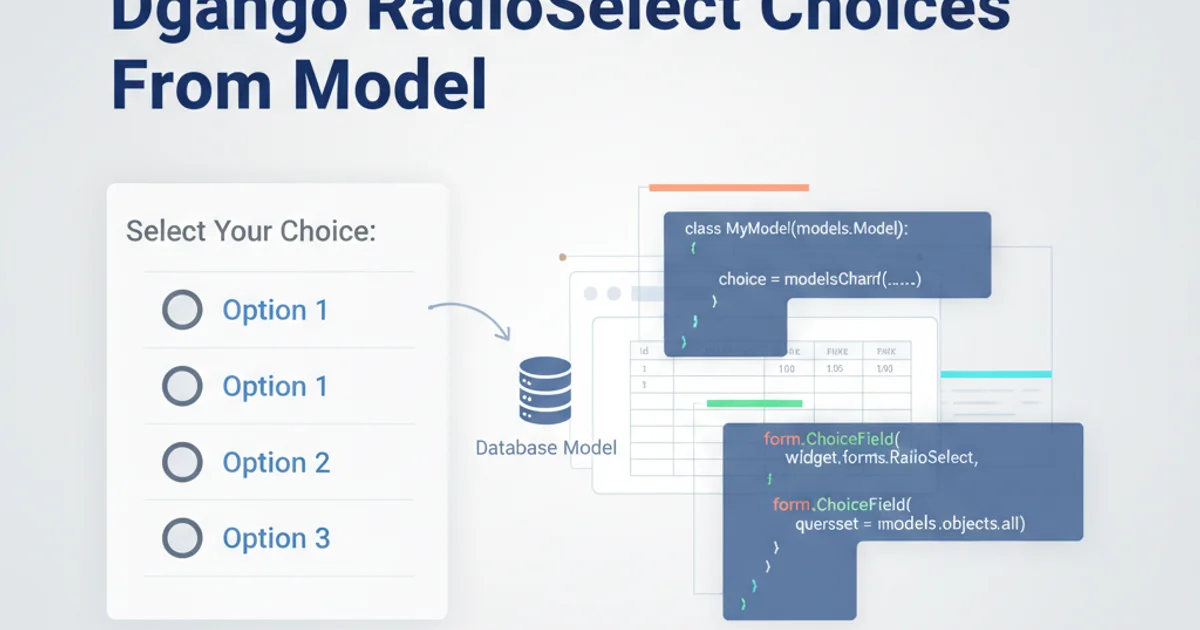Django RadioSelect Choices From Model
Categories:
Dynamic RadioSelect Choices in Django Forms from Model Data

Learn how to populate Django's RadioSelect widget with dynamic choices fetched directly from a database model, enhancing form flexibility and user experience.
Django's RadioSelect widget is excellent for presenting a limited set of mutually exclusive options to users. While you can define choices statically, many real-world applications require these choices to be dynamic, often sourced from a database model. This article guides you through the process of populating RadioSelect choices directly from your Django models, ensuring your forms are always up-to-date with your application's data.
Understanding RadioSelect and Model Choices
The RadioSelect widget renders a list of radio buttons. In Django forms, choices for fields using this widget are typically provided as a list of 2-tuples (value, label). When these choices need to come from a database, you'll fetch records from a model and transform them into this (value, label) format. This approach is particularly useful for categories, statuses, or any predefined lists managed within your application's data.
flowchart TD
A[Start: User requests form] --> B{Form Initialization}
B --> C[Fetch data from Django Model]
C --> D[Transform Model Objects to (value, label) tuples]
D --> E[Assign tuples to Form Field's 'choices']
E --> F[Render Form with RadioSelect]
F --> G[End: User interacts with form]Flowchart of dynamically populating RadioSelect choices from a Django Model.
Step-by-Step Implementation
Let's walk through an example where we have a Category model, and we want to display these categories as radio button choices in a form.
# models.py
from django.db import models
class Category(models.Model):
name = models.CharField(max_length=100, unique=True)
description = models.TextField(blank=True)
def __str__(self):
return self.name
# Make migrations and migrate:
# python manage.py makemigrations
# python manage.py migrate
Next, we'll define our Django form. Instead of hardcoding choices, we'll fetch them dynamically in the form's __init__ method.
# forms.py
from django import forms
from .models import Category
class ProductForm(forms.Form):
name = forms.CharField(max_length=200)
description = forms.CharField(widget=forms.Textarea)
category = forms.ChoiceField(
widget=forms.RadioSelect,
choices=[] # Initialize with an empty list
)
def __init__(self, *args, **kwargs):
super().__init__(*args, **kwargs)
# Fetch categories from the database
categories = Category.objects.all()
# Transform them into (value, label) tuples
self.fields['category'].choices = [
(category.id, category.name) for category in categories
]
category.id as the value and category.name as the label is a common and recommended practice. The ID provides a stable, unique identifier for backend processing, while the name is user-friendly.Finally, integrate this form into your Django view and template.
# views.py
from django.shortcuts import render, redirect
from .forms import ProductForm
def create_product(request):
if request.method == 'POST':
form = ProductForm(request.POST)
if form.is_valid():
# Process the form data
# For example, save a new product with the selected category
selected_category_id = form.cleaned_data['category']
# ... further processing ...
return redirect('success_page') # Redirect after successful submission
else:
form = ProductForm()
return render(request, 'myapp/product_form.html', {'form': form})
<!-- myapp/templates/myapp/product_form.html -->
<!DOCTYPE html>
<html>
<head>
<title>Create Product</title>
</head>
<body>
<h1>Create New Product</h1>
<form method="post">
{% csrf_token %}
{{ form.as_p }}
<button type="submit">Submit</button>
</form>
</body>
</html>
Advanced Considerations
While the basic implementation is straightforward, consider these points for more robust applications:
__init__ ensures the form always displays the latest options. However, for very large datasets, consider caching or pagination to optimize performance.Filtering Choices
You might not always want to display all instances of a model. You can filter the queryset in your form's __init__ method to show only relevant choices.
# forms.py (modified)
# ... (imports and other fields)
class ProductForm(forms.Form):
# ... (name, description fields)
category = forms.ChoiceField(
widget=forms.RadioSelect,
choices=[]
)
def __init__(self, *args, **kwargs):
super().__init__(*args, **kwargs)
# Fetch only active categories
active_categories = Category.objects.filter(is_active=True)
self.fields['category'].choices = [
(category.id, category.name) for category in active_categories
]
Using ModelChoiceField with RadioSelect
For a more Django-idiomatic approach when dealing with foreign keys, you can use ModelChoiceField. However, ModelChoiceField by default renders as a <select> dropdown. To make it render as RadioSelect, you need to explicitly set its widget.
# forms.py (using ModelChoiceField)
from django import forms
from .models import Category
class ProductModelForm(forms.ModelForm):
class Meta:
model = Product # Assuming you have a Product model with a ForeignKey to Category
fields = ['name', 'description', 'category']
widgets = {
'category': forms.RadioSelect
}
def __init__(self, *args, **kwargs):
super().__init__(*args, **kwargs)
# If you need to filter the queryset for ModelChoiceField:
# self.fields['category'].queryset = Category.objects.filter(is_active=True)
ModelChoiceField, the choices attribute is automatically populated by Django based on the queryset. You only need to set the widget to RadioSelect.